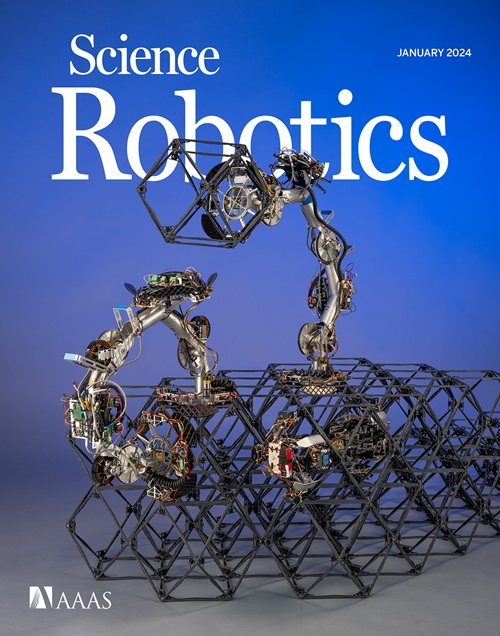Highly agile flat swimming robot
IF 27.5
1区 计算机科学
Q1 ROBOTICS
Science Robotics
Pub Date : 2025-02-19
引用次数: 0
Abstract
Navigating and exploring the surfaces of bodies of water allow swimming robots to perform a range of measurements while efficiently communicating and harvesting energy from the Sun. Such environments are often highly unstructured and cluttered with plant matter, animals, and debris, which require robots to move swiftly. We report a fast (5.1 centimeters per second translation and 195 degrees per second rotation), centimeter-scale swimming robot with high maneuverability and autonomous untethered operation. Locomotion is enabled by a pair of soft, millimeter-thin, undulating pectoral fins, in which traveling waves are electrically excited to generate propulsion. The actuators, robot design, and power supply are codesigned to enable high-performance locomotion in a scaled-down system. A single soft electrohydraulic actuator per side generates the traveling wave. A compact and lightweight power supply enables untethered operation, made possible by decreasing the operating voltage of the electrohydraulic actuators to below 500 volts and their power consumption to 35 milliwatts. By an experimental study and by modeling, we determined optimum dimensions and operating conditions across designs and size scales. The robots navigate through narrow spaces and through grassy plants and push objects weighing more than 16 times their body weight. Such robots can allow exploration of complex environments as well as continuous measurement of plant and water parameters for aquafarming.
高度敏捷的平面游泳机器人
导航和探索水体表面使游泳机器人能够进行一系列测量,同时有效地沟通和收集来自太阳的能量。这样的环境通常是非结构化的,到处都是植物、动物和碎片,需要机器人快速移动。我们报告了一种快速(5.1厘米/秒的平移和195度/秒的旋转)的厘米级游泳机器人,具有高机动性和自主无系绳操作。运动是由一对柔软的、毫米厚的起伏胸鳍实现的,其中的行波被电激发以产生推进力。执行器、机器人设计和电源是共同设计的,可以在缩小的系统中实现高性能运动。每侧有一个软电液驱动器产生行波。通过将电液执行器的工作电压降至500伏以下,功耗降至35毫瓦,轻巧的电源可以实现不受束缚的操作。通过实验研究和建模,我们确定了各种设计和尺寸尺度的最佳尺寸和操作条件。这些机器人可以在狭窄的空间和长满草的植物中穿行,并推动重量超过其体重16倍的物体。这种机器人可以探索复杂的环境,也可以连续测量水产养殖的植物和水参数。
本文章由计算机程序翻译,如有差异,请以英文原文为准。
求助全文
约1分钟内获得全文
求助全文
来源期刊

Science Robotics
Mathematics-Control and Optimization
CiteScore
30.60
自引率
2.80%
发文量
83
期刊介绍:
Science Robotics publishes original, peer-reviewed, science- or engineering-based research articles that advance the field of robotics. The journal also features editor-commissioned Reviews. An international team of academic editors holds Science Robotics articles to the same high-quality standard that is the hallmark of the Science family of journals.
Sub-topics include: actuators, advanced materials, artificial Intelligence, autonomous vehicles, bio-inspired design, exoskeletons, fabrication, field robotics, human-robot interaction, humanoids, industrial robotics, kinematics, machine learning, material science, medical technology, motion planning and control, micro- and nano-robotics, multi-robot control, sensors, service robotics, social and ethical issues, soft robotics, and space, planetary and undersea exploration.
 求助内容:
求助内容: 应助结果提醒方式:
应助结果提醒方式:


